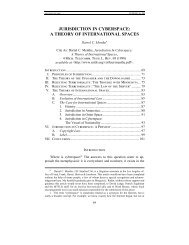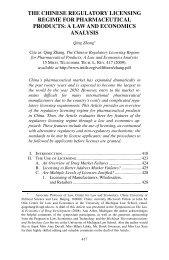282 <strong>Michigan</strong> <strong>Telecommunications</strong> <strong>and</strong> <strong>Technology</strong> Law Review [Vol. 19:279identified because they were withheld as proprietary or trade secrets. 7 Despitethese information limitations, the Committee concluded that more than650 hydraulic fracturing products contained known carcinogens, chemicalsregulated under the Safe Drinking Water Act, or hazardous air pollutants. 8The growing concern over the use of dangerous chemicals in hydraulicfracturing has led to a call for greater disclosure. Companies may soon berequired to produce public lists of chemicals used, even when trade secretsare involved. 9 But this may not solve the information problem. A completeunderst<strong>and</strong>ing of the impact of hydraulic fracturing chemicals cannot begained from a mere list of the compounds used. It is just as important tounderst<strong>and</strong> how they interact with each other as well as how they act in thereal world. As with agricultural technologies such as genetically modifiedcrops, simply knowing the structure of the chemicals or the steps in amethod of use is not sufficient. Field <strong>and</strong> laboratory experimentation is necessaryto fully capture how the exploitation of shale gasses impacts the environment.Normally, third parties such as NGOs <strong>and</strong> universities would beable to fill this information gap by conducting experiments, but patents mayplay a new <strong>and</strong> surprising role in limiting this important source of informationproduction.The patent system is generally viewed as a means for disseminating informationas much as providing an incentive to innovate. 10 Rapid informationdisclosure is part of the bargain with the patentee. However, patentdisclosure relates only to the invention itself, as opposed to its impact on theworld. When reproduction or use of the patented invention is necessary tounderst<strong>and</strong> how it impacts the rest of the world, patent rights can actuallyserve as a barrier. The lack of an effective non-patentee experimental useexception in patent law means that there is little immunity for one’s researchin exploring patent impacts. Moreover, recent changes to U.S. patent law inthe America Invents Act have exp<strong>and</strong>ed the benefits of keeping an inventionsecret, thereby reducing the need for a patent race in order to preserve use of7. Id.8. Id. at 8.9. Currently, federal law regarding disclosure is somewhat limited, with only releasesof hazardous chemicals as defined by the Comprehensive Environmental Response, Compensation<strong>and</strong> Liability Act (“CERCLA”) subject to m<strong>and</strong>atory disclosure. Rebecca J. Reser &David T. Ritter, State <strong>and</strong> Federal Regulation of Hydraulic Fracturing, 57 ADVOC. (TEX.) 31,32–33 (2011). However, new regulations have been proposed. Additionally, states such asPennsylvania <strong>and</strong> Texas have disclosure rules in place. Id. at 33; Michael Dillon, Water Scarcity<strong>and</strong> Hydraulic Fracturing in Pennsylvania: Examining Pennsylvania Water Law <strong>and</strong>Water Shortage Issues, 84 TEMP. L. REV. 201, 208 n.65 (2011).10. See, e.g., Seymour v. Osborne, 78 U.S. (11 Wall.) 516, 533 (1870) (“Letters patentare . . . public franchises . . . tending to promote the progress of science <strong>and</strong> the useful arts, <strong>and</strong>as matter of compensation to the inventors for their labor, toil, <strong>and</strong> expense in making theinventions, <strong>and</strong> reducing the same to practice for the public benefit . . . .”).
Spring 2013] <strong>Fracking</strong> <strong>Patents</strong> 283the technology. 11 Overall, the U.S. may be experiencing an unexpectedemergence of patents as information-containment tools while the disclosurefunction of patents has been weakened.Empirical data in the context of hydraulic fracturing supports this shiftin the relationship between patents <strong>and</strong> information. As a complement to thediscussion on patent rights, this Article presents data on patent activity in theoil <strong>and</strong> gas industry derived from the U.S. Patent <strong>and</strong> Trademark Office(“USPTO”). Our analysis reveals that at the very moment when the use ofhydraulic fracturing was becoming more widespread, visible, <strong>and</strong> controversial,patenting activity related to the practice began to rise. As the questions<strong>and</strong> controversies surrounding hydraulic fracturing multiply, so do the numberof issued <strong>and</strong> pending patents. This Article posits a novel perspective onthis data. Simply put, given the dem<strong>and</strong> for disclosure, companies could beparadoxically pursuing patenting in part as a means of information containment.This argument runs counter to the dominant view of patents as mechanismsfor disclosure.This Article considers patents as information-containment tools by comprehensivelyinvestigating their role in hydraulic fracturing <strong>and</strong> predictingtheir future applicability. Part I describes the history of hydraulic fracturing<strong>and</strong> the related significance of patents. Part II explains how patents can legallyfunction as a tool to prevent information disclosure, particularly inview of the limited experimental use exception. Part III demonstrates howpatents are likely to be used to impact information specific to hydraulic fracturingtechnology. Finally, Part IV provides some possible solutions, highlightingthe role of the public university.I. THE HISTORIC DEVELOPMENT OF HYDRAULIC FRACTURING AS ATECHNOLOGY AND ITS CAPTURE THROUGH PATENTSThe commercial development of hydraulic fracturing dates back to thelate 1940s. Its evolution as a technology is a story of creativity, experimentation<strong>and</strong>, ultimately, definition through property rights. The latter is criticalas a means of extending innovation impacts beyond market control.A. Evolving Science in Fluid <strong>and</strong> PressureThe first hydraulic fracturing experiment was performed in July 1947 inHugoton, Kansas, when Stanolind Oil & Gas Company (later Amoco <strong>and</strong>then BP) attempted to stimulate production on its Kelpper No. 1 well. 12 Althoughwell performance did not improve much, the technology showed11. Leahy-Smith America Invents Act, Pub. L. No. 112-29, § 5, 125 Stat. 284, 297–99(2011).12. GEORGE C. HOWARD & C. ROBERT FAST, HYDRAULIC FRACTURING 8 (1970).






